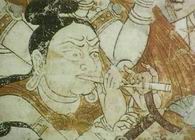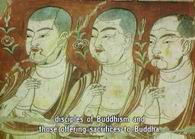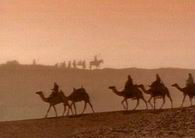 |
|
Paziklike |
| CCTV.COM 2003-09-27 09:09:50 |
|
The Paziklike Thousand-Buddha Cave is located in the Turpan Basin in Xinjiang, northwest China. It was an imperial temple of the Northern Liang Dynasty and the Northern and Southern Dynasties. Construction of the cave began in the 4th century during the Northern and Southern Dynasties.
 The earliest record of the Paziklike Thousand-Buddha Cave can be seen in the “Illustrated Book of the Western Regions of Tang.” The earliest record of the Paziklike Thousand-Buddha Cave can be seen in the “Illustrated Book of the Western Regions of Tang.”
“Paziklike flourished mainly in the period of Gaochang Kingdom or Huihu Gaochang. The area was close to the Central Plains. Closer ties were established between the Central Plains and the Western Regions. According to the pictures of Paziklike I have seen, its grottoes were of a richer Han style than those of Kumutula,” said Liu Xilin, director of Research Department of China Art Gallery
The earliest murals in the Paziklike Thousand-Buddha Cave were painted in the 4th century. The latest murals were painted in the 12th century. The art of murals there spanned almost 1,000 years.
 Murals painted in the early period in the Paziklike grottoes preached Buddhist meditation. Most of the murals portrayed stories of Buddha’s previous incarnation and principal and subsidiary causes. After the nirvana of Sakyamuni, princes of 16 states in India came to express their condolences. The images of the 16 princes on the murals were Sinicized. They included Han emperors wearing crowns and princes of the Turk, Huihu and other ethnic groups. Murals painted in the early period in the Paziklike grottoes preached Buddhist meditation. Most of the murals portrayed stories of Buddha’s previous incarnation and principal and subsidiary causes. After the nirvana of Sakyamuni, princes of 16 states in India came to express their condolences. The images of the 16 princes on the murals were Sinicized. They included Han emperors wearing crowns and princes of the Turk, Huihu and other ethnic groups.
“Buddhism was deified. As it was preached, it became more and more secular. When painters portrayed images of Buddha, they broke away from original patterns. They added shapes of figures in life. In Paziklike today, we can see
figures of various ethnic groups. They included the King of Huihu, local noblemen, Han monks, disciples of Buddhism and those offering sacrifices to Buddha. Images of Han people were different from those of ethnic minorities. Images of some ethnic minorities were different from those of others. They added a lot of colour featuring the local people,” said Liu Xilin.
In A.D. 640, the Tang Dynasty unified the Western Regions that had been carved up into separate regimes for many years. The style of painting on the Central Plains was introduced into the Western Regions. It was represented by the great painter Wu Daozi who did painting with vigorous brushes and light colours.
 Many large murals of Buddha such as “Buddhist Stories Retold” and “Stories of Nirvana” appeared in the grottoes built later. With two metres in height, the images of Buddha look composed and graceful. They hold musical instruments and ornaments in their hands. The painters employed techniques of artistic exaggeration to depict beautiful lines, figures and refined qualities on the images of Buddha and Bodhisattvas. Many large murals of Buddha such as “Buddhist Stories Retold” and “Stories of Nirvana” appeared in the grottoes built later. With two metres in height, the images of Buddha look composed and graceful. They hold musical instruments and ornaments in their hands. The painters employed techniques of artistic exaggeration to depict beautiful lines, figures and refined qualities on the images of Buddha and Bodhisattvas.
“We Chinese maintain that man is in harmony with nature. We also maintain that man is in harmony with deities. The worshippers hope to attain divinity in the future. People also hope to get closer and closer to deities. This means that they hope to get close to the laws of nature and the universe. So they can attain harmony between man and the universe, a lofty realm of ethnics, harmony between man and Buddha and harmony of one’s mentality. I think this harmony is also the aesthetic taste of the Chinese,” said Liu Xilin.
Every grotto in Paziklike is the symbol of an era and the epitome of a historical civilization. When we enter the grottoes one after another, we feel as if we entered the remote past one era after another.
|
|
Editor: Han Ling CCTV.com
|
|
|
|
|
|
 |









